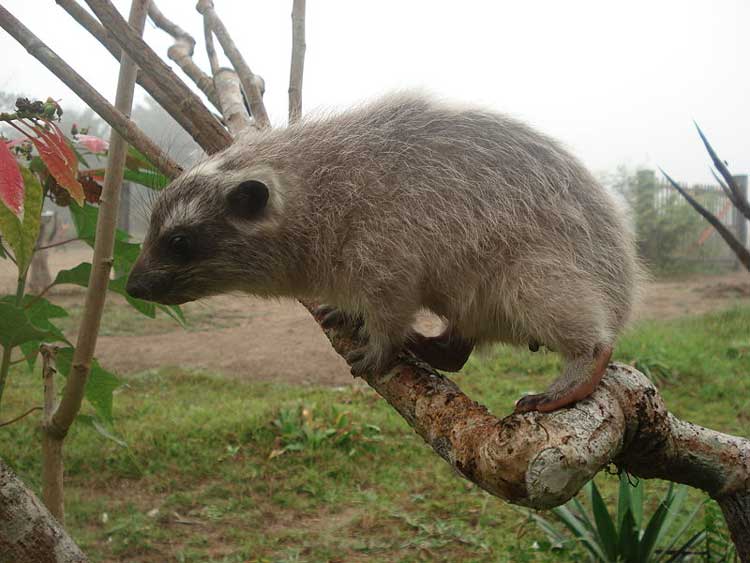
Dendrohyrax dorsalis (*)
Superregnum: Eukaryota
Cladus: Unikonta
Cladus: Opisthokonta
Cladus: Holozoa
Regnum: Animalia
Subregnum: Eumetazoa
Cladus: Bilateria
Cladus: Nephrozoa
Superphylum: Deuterostomia
Phylum: Chordata
Subphylum: Vertebrata
Infraphylum: Gnathostomata
Megaclassis: Osteichthyes
Cladus: Sarcopterygii
Cladus: Rhipidistia
Cladus: Tetrapodomorpha
Cladus: Eotetrapodiformes
Cladus: Elpistostegalia
Superclassis: Tetrapoda
Cladus: Reptiliomorpha
Cladus: Amniota
Cladus: Synapsida
Cladus: Eupelycosauria
Cladus: Sphenacodontia
Cladus: Sphenacodontoidea
Cladus: Therapsida
Cladus: Theriodontia
Subordo: Cynodontia
Infraordo: Eucynodontia
Cladus: Probainognathia
Cladus: Prozostrodontia
Cladus: Mammaliaformes
Classis: Mammalia
Subclassis: Trechnotheria
Infraclassis: Zatheria
Supercohors: Theria
Cohors: Eutheria
Magnordo: Epitheria
Superordo: Afrotheria
Cladus: Paenungulata
Ordo: Hyracoidea
Familia: Procaviidae
Genus: Dendrohyrax
Species: Dendrohyrax dorsalis
Subspecies
Dendrohyrax dorsalis dorsalis (Fraser, 1854)
Dendrohyrax dorsalis emini Thomas, 1887
Dendrohyrax dorsalis latrator (Thomas, 1910)
Dendrohyrax dorsalis marmota (Thomas, 1901)
Dendrohyrax dorsalis nigricans (Peters, 1879)
Dendrohyrax dorsalis sylvestris (Temminck, 1855)
Name
Dendrohyrax dorsalis (Fraser, 1855)
Vernacular names
Afrikaans: Westelike boomdassie
Ελληνικά: Δυτικός Δενδρύραξ
English: Western Tree Hyrax
magyar: Nyugat-afrikai fakúszószirtiborz
日本語: ニシキノボリハイラックス
português: Hirax-arbóreo-do-oeste

Dendrohyrax dorsalis emini
The western tree hyrax (Dendrohyrax dorsalis), also called the western tree dassie or Beecroft's tree hyrax, is a species of tree hyrax within the family Procaviidae. It can be distinguished from other hyraxes by short coarse fur, presence of white patch of fur beneath the chin, lack of hair on the rostrum, and lower crowns of the cheek teeth compared to other members of the same genus.[3]
Description
The western tree hyrax is similar in appearance to a large guinea pig. It has a head-and-body length of between 440 and 570 mm (17.3 and 22.4 in) and a stumpy tail. The pelage is thick and coarse, with a few yellowish hairs scattered among the dark brown and blackish ones; pale individuals with cream-coloured coats have also been observed. Scattered long sensory hairs similar to whiskers are present in the coat. The snout is free from fur, the ears are small and rounded and sometimes tipped with white, and the chin bears a white spot. There is a dorsal scent gland up to 70 mm (2.8 in) long in the centre of the back, surrounded by a yellowish patch of fur.[4]
Behavior
Western tree hyraxes tend to be solitary, and only occasionally are found in groups of two or three. They are nocturnal and generally feed at night. It has been noted that this species is an especially adept climber. In captivity they have been observed to climb up the edge of an open door with ease, as well as being able to quickly scale smooth tree trunks. They are aided in climbing with their black, pliant footpads with numerous ridges. Captive animals were observed using their teeth to help hold on to wires and vines while climbing.[5]
The gestation period is about eight months with a litter size one or two young.[4]
Ecology
Common predators of the western tree hyrax are eagles, leopards, hawks, servals, pythons, and golden cats, in addition to occasionally being hunted by humans for food. In Bossou, Guinea, one notable ecological association with chimpanzees occurs. A chimpanzee at Bossou was observed capturing a western tree hyrax, carrying it to her nest, and sleeping with and grooming it. This suggests that chimpanzees in Bossou may not regard hyraxes as a prey animal.[6]
Range and habitat
D. d. emini
The Western Tree Hyrax is found in West and Central Africa: Benin, Cameroon, Central African Republic, Republic of the Congo, Democratic Republic of the Congo, Ivory Coast, Equatorial Guinea, Gabon, Gambia, Ghana, Guinea, Guinea-Bissau, Liberia, Nigeria, Rwanda, Senegal, Sierra Leone, Sudan, Togo, Uganda, and possibly Niger. Its natural habitats are subtropical or tropical moist lowland forests, moist savanna, and rocky areas.[2]
References
Shoshani, J. (2005). Wilson, D.E.; Reeder, D.M. (eds.). Mammal Species of the World: A Taxonomic and Geographic Reference (3rd ed.). Johns Hopkins University Press. pp. 87–88. ISBN 978-0-8018-8221-0. OCLC 62265494.
Butynski, T.; Dowsett-Lemaire, F.; Hoeck, H. (2015). "Dendrohyrax dorsalis". IUCN Red List of Threatened Species. 2015: e.T6410A21282601. doi:10.2305/IUCN.UK.2015-2.RLTS.T6410A21282601.en. Retrieved 15 November 2021.
Kowalski, K. (1976). Mammals, and outline of theriology. Panstwowe Wydawnicto Naukowe, Warszawa. English Edition. pp. 617
Jonathan Kingdon; David Happold; Thomas Butynski; Michael Hoffmann; Meredith Happold; Jan Kalina (2013). Mammals of Africa. A&C Black. pp. 155–157. ISBN 978-1-4081-8996-2.
Jones, C. (1978). "Dendrohyrax dorsalis". Mammalian Species (113): 1–4. doi:10.2307/3504007. JSTOR 3504007.
Hirata, S.; Yamakoshi, G.; Fujita, S.; Ohashi, G.; Matsuzawa, T. (2001). "Capturing and toying with hyraxes (Dendrohyrax dorsalis) by wild chimpanzees (Pan troglodytes) at Bossou, Guinea". American Journal of Primatology. 53 (2): 93–97. doi:10.1002/1098-2345(200102)53:2<93::AID-AJP5>3.0.CO;2-X. PMID 11170171. S2CID 7050805.
Retrieved from "http://en.wikipedia.org/"
All text is available under the terms of the GNU Free Documentation License

